Movie Info
Movie Info
- Director
- Herbert J. Biberman
- Run Time
- 1 hour and 33 minutes
- Rating
- Not Rated
VP Content Ratings
- Violence
- 2/10
- Language
- 0/10
- Sex & Nudity
- 1/10
- Star Rating
Relevant Quotes
You are the salt of the earth; but if salt has lost its taste, how can its saltiness be restored? It is no longer good for anything, but is thrown out and trampled under foot.
I have shown this film to many groups over the years, and despite its technical limitations, the response has always been positive and enthusiastic. Most of its crew and actors, including its director Herbert J. Biberman, were members of the “Hollywood Ten,” filmmakers during the infamous Reds witch-hunt of the late 1940’s and 1950’s who were banned by the Hollywood studios because members of this courageous group refused to testify before the H.U.A.C. concerning their friends’ alleged Communist activities. Biberman even spent six months in prison for his refusal to testify. Undaunted, in 1953 the director and company went ahead to make this film based on a real life zinc mine strike in New Mexico.
The Latino miners, faced with inhumane safety conditions at the mines and a pay scale far below that being paid to Anglos for the same work, decide to go on strike after their pleas are brushed aside by management. The women also have their grievances—no indoor plumbing, tumbledown shacks for living quarters, and more—but their men, unconsciously emulating the white mine owners, dismiss their complaints as unimportant. Like Harlan County War, Biberman’s film concentrates on a couple, Ramon (Juan Chacón) and Esperanza (Rosaura Revueltas) Quintero.
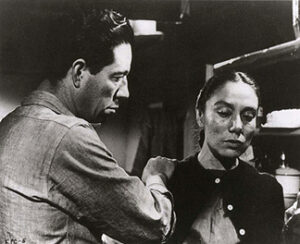
Pregnant with her third child, Esperanza is very much under the thumb of her domineering husband Ramon when we first see her, she even saying that she does not want to bring a child into this world. She turns down an invitation from her female neighbors to sign a petition for better living conditions because her husband would not approve her doing so. A most dramatic moment occurs when, following a mine accident, the manager orders the men back into the mine. There is a long silence, and then, the men refusing, we see them shutting down the machinery, and everything comes to a halt. With no more machinery sound the silence is dramatic. Ramon joins the strikers, and they set up their picket line to turn back the scabs brought in by the owners. Matters come to a crisis when, as in the more recent film, the company-owned judge enjoins the strikers against having more than three men on the picket line.
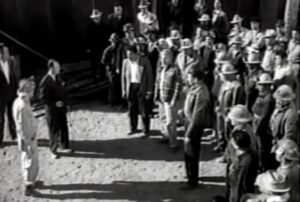
The women attend the union meeting called to discuss the tense situation. At first they merely listen as their men discuss the cruel choice of going to jail or obeying the order—either way it looks as if the scabs will be able to drive through, thus breaking the strike. Then the women call attention to the wording of the injunction—it enjoins miners from picketing. They, the speaker points out, are miners wives, not miners, and therefore could take up picketing duties. The men are skeptical—and also worried about who would take care of the children and do the household chores. The women leave no doubt as to whom such duties would fall, something the men do not like at all. Nonetheless, out of desperation, a slim majority of the miners vote to give the women a chance, even though many of them are convinced the females are not tough enough to stand up against the strikebreakers.
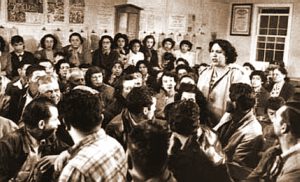
Esperanza, to the consternation of Ramon, joins the women, and they eventually prove that they do indeed have staying power and are strong enough to withstand the onslaught of the company-owned sheriff (Will Geer—hard to believe that the future “Grandpa” of The Waltons once was considered a dangerous subversive!) and the would-be strikebreakers. What makes this film so outstanding is that it deals not just with the ins and outs of labor conflict but also with the struggle for women to win dignity and a rightful place in the scheme of things. Their great effort is told with considerable humor, adding to the enjoyment of watching the film.
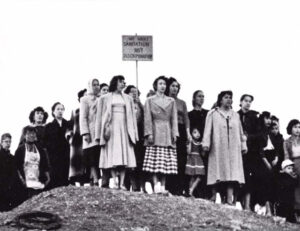
Shot on a shoestring budget in black and white, with many of the non-professional actors miners themselves, Salt of the Earth is one of the most important films of the early 1950’s. And one of the least seen. Theater owners and the projectionists’ union refused to show it because of the “Communists” who made it, and somewhere I read that the U.S. Congress actually passed a bill banning the film. After languishing in a vault for many years the film has been rescued by video and is now available in both DVD format. It is not only a classic social justice, but, as I stated at the beginning, also a film that still stirs the hearts of audiences willing to overlook some of its technical crudities.
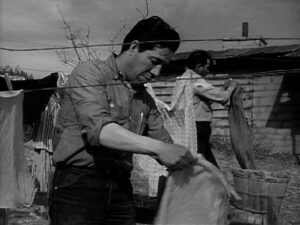
Note: The story behind the making of this unusual film is as dramatic as the film itself and can be found on the website of Historynet and also in the British newspaper The Guardian.
You can watch this film free on YouTube by clicking here.

